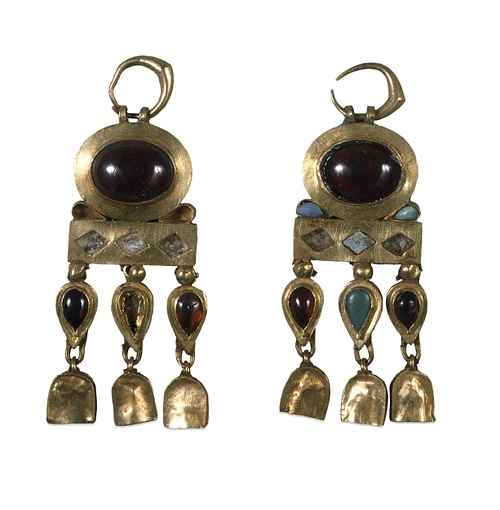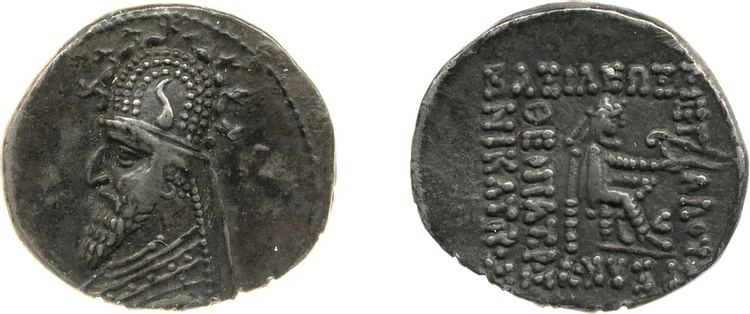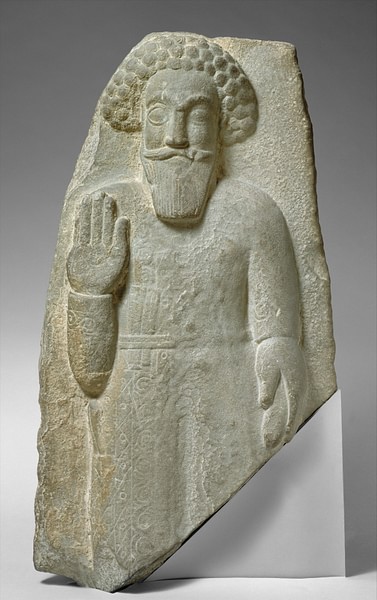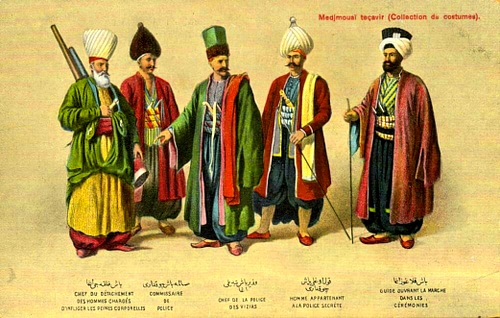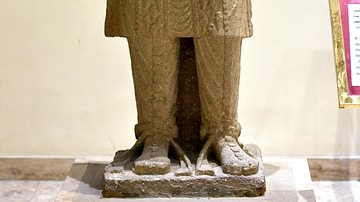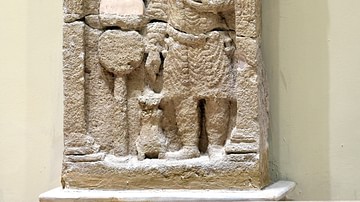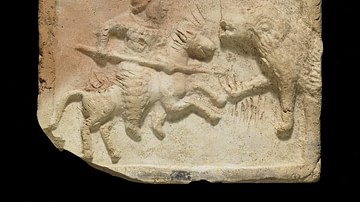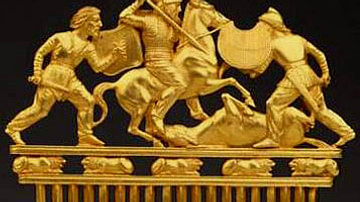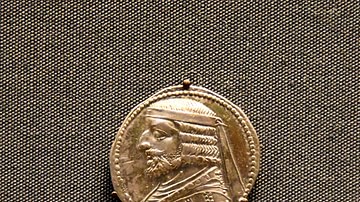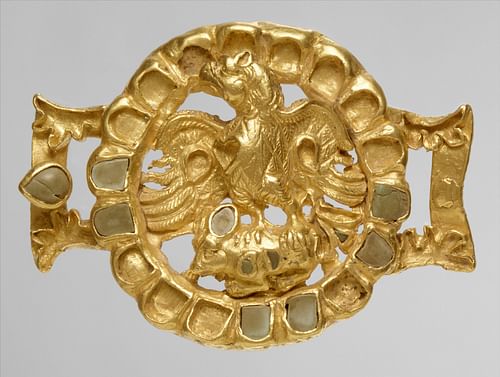
Parthian Art flourished within the Eurasian cultural corridor from the late hundreds BCE to the early 1st and 2nd centuries CE. With the Parthian Empire (247 BCE - 224 CE) stretching from India and China in the east to the Mediterranean shores in the west, having taken over the Seleucid Empire (312-63 BCE) of many peoples and cultures, influences came from many quarters. Borrowing from the east and west, theirs was an amalgam easily identified as Parthian. Not only did they create their own distinct, almost outlandish dress, their frontal and circular motifs in art and architecture and their use of geometric and floret design for wall décor have influenced patterns of art that resonate in the Middle East to this day.
Cultural Influences
Coming off the steppe of Central Asia east of the Caspian Sea, the Parthians would have at first brought with them cultural influences from their Scythian cousins. From their beginnings, it appears they may have kept musical influences common to Scythia and Asia as a whole. But in their interaction with the Seleucid Greeks, while they would at first adopt Greek dress, they would return to the trouser and tunic motif of their origins.
Some scholars have surmised Parthia's departure from Hellenistic influences was because of its competition with Rome. Either way, different from the Seleucid Greeks, the Parthians developed their own unique artistic and architectural styles. But ultimately, because of their empire's location and their origin in Central Asia, the Parthians had as their source a wide range of influences when it came to art and architecture, as Daryoosh Akbarzadeh describes:
Archaeological evidence testifies to the greatness of the culture and art of the Parthian era. The cultural heritage associated with this era has been discovered over a vast expanse, from the borders of China and Central Asia, all the way to Mesopotamia and Syria in the west. (76)
Craft Goods & Craftspeople
Cassius Dio (c. 164 - 229/235 CE) says the main reason for Crassus' (115-53 BCE) attacking Parthia was that they were “exceedingly wealthy.” (40.12) The engine for that prosperity came mainly from their takeover of Mesopotamia. Controlling the lucrative east-west Silk Road through the Euphrates and Tigris river area brought the Parthians high-demand goods from the east, such as silk, spices, nard, and costus root - used for medicinal purposes - that would have been traded and sold at a premium. The accumulation of such wealth created a demand for luxury goods.
With virtually no industrial use for the ancients, gold was the ultimate luxury item fashioned into aesthetic objects of beauty. For the Parthians, plentiful gold was furnished from several of its provinces. Consequently, besides the golden bed, throne, and personal armor of the king and his steed in times of war, the aesthetic use of gold by the nobles appears abundant. Used as gifts from the king to dignitaries and for palace curtains and tapestries, gold-cloth was a common part of noble dress and headdress. Also worn were pointed hats of gold-cloth, and gold ribbons attached to caps. Even more common were armlets, bracelets, necklaces, rings, and earrings of gold. It appears gold was abundant enough, even the reins of some warhorses were studded with gold. Just as sought after, and another reason Rome wanted to defeat Parthia, was rock crystal from India and fluorescent fluorite crystal from Iran. Luxury items from the crystal were wildly coveted and fashioned into eye-appealing cups, goblets, jewelry, and make-up jars.
Part and parcel with what defines a luxury item is that it pleases the eye and contains aesthetic appeal, but even utility items are often stylized. In our world today, the primary function of the car is to get us from point A to point B, but exterior style and interior design have become essential to sales and manufacture. Furniture is the same: beyond function, aesthetics is elemental, and the ancients were no different in this regard. Parthian furniture was more than functional; from their coins, we see what could be a popular chair design, especially among nobles. On more than one issue, the king is shown sitting on what appears to be a ground-level chair with an interesting stacked-sphere design for the chair's legs, seat, and backrest.
While the ruling class enjoyed an elevated level of luxury, creating demand for artists and artisans, the Parthians also invested in improving existing infrastructure and the building of new. Such expansion would mean a demand for architects, builders, and masons. The Parthians accomplished a significant buildout at Ctesiphon near Seleucia on the Tigris, erecting many public buildings and promoting arts and crafts and other commercial activity “profitable to its masters.” (Strabo, Geography 16.1.28) The raised status of the business class would have created its own demand for luxury goods, and artistry would be ubiquitous, even among the business classes.
Art in Architecture
Parthia also benefited their subjects and themselves with great prosperity and a buildout of existing infrastructure with architecture that displayed their own unique artistic tastes. Outside of their fortifications, some of Parthia's more aesthetic projects would include their refurbishment at Ecbatana. Polybius describes Ecbatana as “superior to other cities in wealth and splendor.” A palace near the city's citadel was gargantuan and of great beauty. “Covering ground the circuit of which is nearly seven stades” (nearly a mile around), the palace beams, columns, fretwork, and ceilings were covered with gold and silver, while the floor tiles were all silver (Polybius 10.27). Though much gold and silver had been stripped by Parthian times, since it became the king's summer residence, like their improvements at Ctesiphon, the Parthians likely began to return Ecbatana to its former glory.
In Syria, Parthia made Dura Europas, its provincial administrative center, complete with a palace, Mithraim, bazaar, and typical of their multicultural inclination, a Jewish synagogue. Other projects included the reflourishing of ancient cities like Assur, Uruk, and Nimrud, to include adding fabulous houses and temples with barrel vaulting while incorporating the Parthian architectural innovation of vaulted open-ended entryways called iwans. The influence of the Parthian iwan on Middle Eastern architectural design resonates to this day.
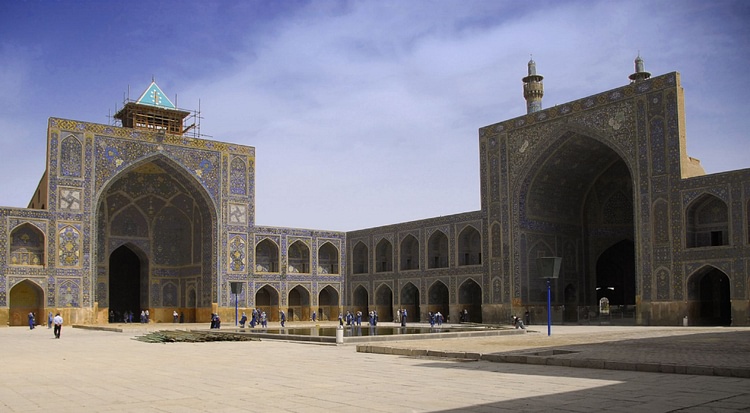
Besides their iwan advent, their architecture employed interesting circular motifs. Architecturally, the Parthians left in place existing Seleucid structures that naturally copied the Hellenistic style rectangular layout with colonnaded and triangular features. However, where it could, the Parthians sought to be different. On entrance to a Greek temple, one passes through a portico of columns. Entering the Parthian temple at Hatra, one arrives under the eye of graceful iwan arches. The blend of Greek-style columns, Parthian capitals, and triangular pediments with multiple Parthian arches at Hatra gives the temple its unique curbside appeal. At Parthian Assur, the use of Parthian arches is again prominently featured.
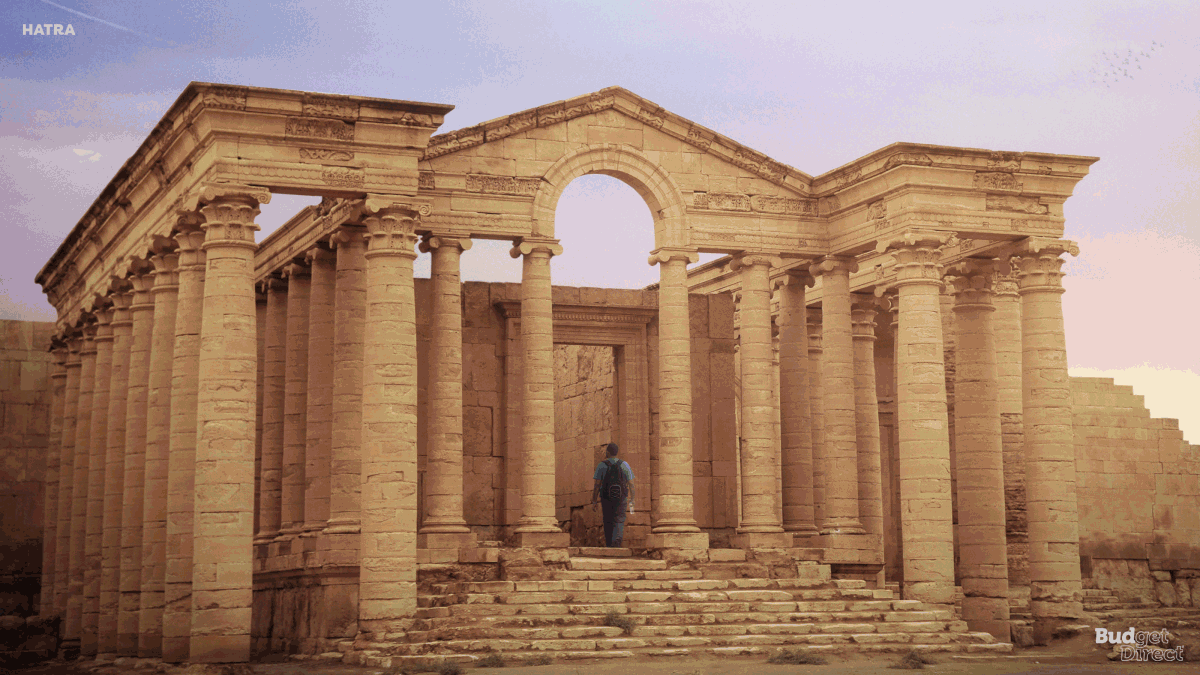
Moreover, at Nisa, their original capital, the Parthians again chose circularity as a prominent architectural feature. There, Parthian architects built a dome that commanded the city's skyline view. Unlike Roman domes that sat on top of supporting structures, the walls of Nisa's dome ran to the ground. A surrounding square edifice contained the outward thrust of the dome's walls. The Central Asian influence may have come from Chorasmia. Comparing the circular mausoleum structures at the Chorasmian necropolis of Tagisken to the Round Hall of Nisa, Antonio Invernizzi states:
The above structures share with the Round Hall the layout of the inner structure - a circle in a square perimeter - and the building technique based on centric elements. With comparable dimensions, the orientation of the buildings is roughly similar and, finally, the function of the buildings is comparable in a more general sense: funerary at Tagisken, commemorative of ancestors at Nisa. (86-87)
Unique Artistic Motifs
While Parthian architecture uniquely incorporated elements of circularity, their art would include the motif of frontality. In comparison, where Egyptian and Persian figures make statements of power, Greek and Roman sculptures look away from the viewer, gazing at someone or something. A stylistic feature the Byzantines would later adopt, Parthian stone figures look straight ahead, making personal connections between themselves and the viewer.
Another distinction is Parthians often drop the more sober facial features or countenance of the Greeks and Romans. Deepening the direct relationship between subject and viewer, some figures appear almost friendly. Moreover, besides the creative fabrication of precious metal jewelry, bronze, terracotta, and marble statues, decorated interior walls are again a testament to Parthian artistic choice and creativity. Wall surfaces at Assur were beautifully adorned with tooled stucco using geometric and floral patterns that are a remarkable precursor of designs adopted by Muslim artists. These decorations would have brightened any room with the application of complementing and contrasting colors.
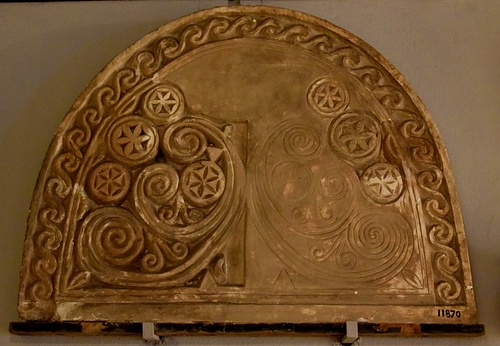
Music & Dance
Though we might think of the Parthians as serious rulers driven to conquer and compete commercially, times of levity and leisure were equally important. Music and dancing are a part of humankind's cultural DNA, and the Parthians were no different. When Surena orchestrated a triumph through Seleucia's streets, singers, dancers, and musicians played a big part. At Parthian feasts, the flute, pipe, and drums were accompanied by the erotic sounds of a stringed instrument called the sambuca. The climax of the celebrations, in harmony and cue with the music, would end with a dance choreography.
While we have few written accounts of Parthia's love of music, we can turn to their cultural cousins, the Scythians, for the sophistication of their ardor. From Scythian kurgans comes a plethora of artifacts depicting daily life. Part of that discovery reveals their love of music. Found at the Sachnovka kurgan is a golden headband showing a man playing the lyre. Pan pipes made from bird bones were found at kurgan 5 at Skatovka. In several tombs at Pazyryk, ox-horn drums were unearthed, but at kurgan 2, an amazing find, a harp-like instrument that had at least four strings was discovered. Barry Cunliffe describes it as “made from a single hollowed-out wooden resonator, the middle part of the body was covered by a wooden sounding board, while sounding membranes were stretched over the open part of the body” (226-27). The tones issued forth from this instrument by a skilled musician must have been truly remarkable.
Parthian Dress
While the Parthians in some ways were liberal in their varietal use of artistic and architectural styles, when it came to clothing, greater uniformity was the norm, at least among the ruling class. Coinciding with the empire's height of power, by the end of the 1st century BCE, the belted tunic and trouser suit became popular throughout the empire. Loose fitted clothing with multiple horizontal pleats, sometimes in exaggerated fashion, became the rave for both sexes. To further accentuate their statement, men's pleated trousers were sometimes made to appear huge around the legs. In one instance, to achieve even greater volume, the pleats appear instead to be amply stuffed and quilted. Sporting lengthy mustaches, often with closely groomed beards, the personal appearance of Parthian nobles included a puffed hairstyle of moderate length secured with a headband. But above all, it was the horizontal pleating that was universal for Parthian nobles.
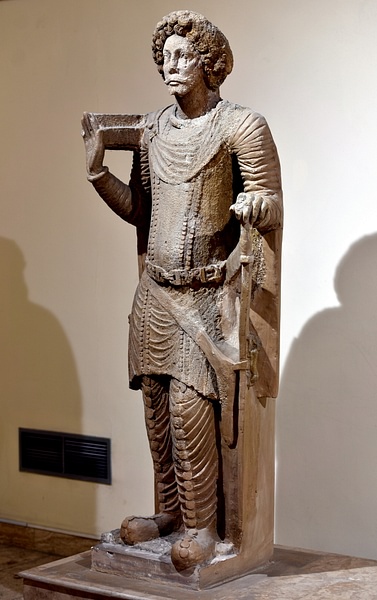
As a rule of thumb, pleating can require two-thirds more fabric than the desired length. The Parthian penchant for top-to-bottom horizontal pleats thus meant an exorbitant use of cloth. Moreover, the loose-fitting appearances depicted on some statuary appear to be the more expensive and coveted silk. Some statuary also reveal copious amounts of intricate leaf and floral embroidery. In contrast with the horizontal pleats, rows of brass, silver, or gold buttons could run vertically, with single lines of “coins” carried all the way to the nobles' shoe tip.
Such an exaggerated display of fashion found on statuary achieved several things for the Parthians. First, it set them apart. The universal characteristics of their shared fashion made them easily identified as Parthians. Wherever they went, a protocol of behavior would be expected. Moreover, knowing who the rulers were by their outfit would have been essential over a vast realm of varied cultures. The diversity of cultures within their realm consequently accentuated the need for uniformity of unique dress. Finally, the copious use of expensive fabric, time-consuming embroidery, festooned adornment also made a statement of distinct wealth. Though known for their diplomacy and open-mindedness toward different cultures within their realm, their extreme affluence was nevertheless won and maintained by military might. Hence, the display of wealth in their dress also signaled a display of Parthian might.
Legacy
As recent discovery attests, the origin of trousers was a practical invention by a horse-riding people of Central Asia c. 3,000 years ago. From horse cultures themselves, the Scythians and Parthians also wore them, but it was the Parthians who brought the tunic/trouser suit to a new height of style as a unique and identifiable fashion of the ruling class. While the Sasanians, Parthia's successors, carried on with their version of the tunic-trouser suit, it would be the Ottoman Turks who would more broadly return to the elongated tunic and Parthian type ballooned-trouser called the sirwal. The sirwal, in different forms, garners popularity even today.
Artistically, the frontality and friendliness motifs of their paintings and sculpture have been influential as well. While the direct gaze from subject to viewer is a theme used by artists today, Byzantine artists also incorporated it, though with ever sober countenances. By contrast and maybe unique to the Parthians, it seems few craftspeople have attempted such direct, friendly communication. One theme is raised hands holding gifts of hospitality; another is where the subject waves to the viewer. Interestingly, Parthian imagery may also indicate the way they governed: with a diplomacy-first, friendly, accommodating attitude toward the people they governed, reminding though of Parthia's disposition for war if needed.
Finally, architecturally, when comparing the Parthian advent of the iwan entrance and double storied arched niches for exterior wall aesthetics to modern Middle Eastern architecture, the similarities are remarkable. Moreover, while Parthia's attempt at an amalgam of eastern circularity with western rectangular and triangular architectural elements is evident at Hatra, their use of geometric and floret wall décor has also had widespread influence. As Parvaneh Pourshariati states:
In art, architecture, and even traditions of rule, the Parthian contribution to subsequent Iranian culture and to the cultural traditions of the regions as a whole are being gradually and increasingly established. (23-24)
